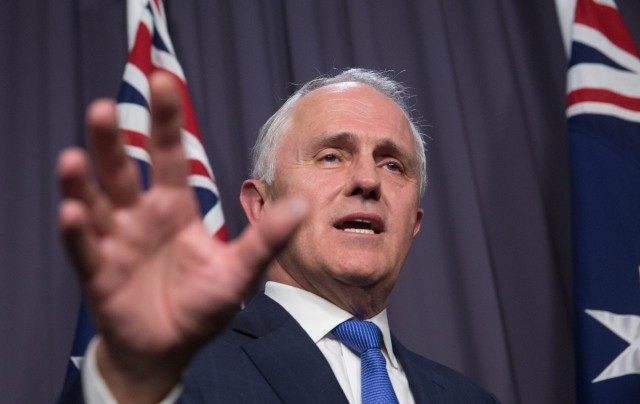After only two years in office, Australia’s Prime Minister, Tony Abbott, has been knocked out of office by a revolt within his Liberal Party, replaced by a far more liberal (as Americans understand the term) party leader, Malcolm Turnbull. Turnbull becomes the fifth Prime Minister of Australia in five years.
This is not the first time Abbott’s leadership was challenged with an intra-party ambush, known as a “spill” vote. In essence, the governing party can call a vote on very short notice and vacate its leadership position, which also removes that person from the Prime Minister position. There aren’t many built-in advantages for the incumbent in a spill vote – he basically has to run for his job all over again, and win the majority of a hundred voters or so from the party’s parliamentary representatives, in a “campaign” that only lasts a day or two.
One of the few intrinsic advantages for the incumbent PM lies in arguing that his sudden ejection is a bad move that makes the government seem confused and unstable. Abbott played that card, saying that his office was “not a prize or a plaything to be demanded.”
“I firmly believe that our party is better than this, that our government is better than this and, by God, that our country is so much better than this,” Abbott declared.
He and his supporters further argued that such leadership shuffles were uncomfortably similar to the conduct of the Liberal Party’s opponents in the Labor Party. “The position of prime minister is a gift of you, the Australian people. You have the right to hire and only you have the right to fire. We cannot, we must not, become a carbon copy of the Labor party,” said Treasurer Joe Hockey, who the Sydney Morning Herald predicted would lose his job in the aftermath of Abbott’s ouster.
However, this leadership challenge was far better organized than the failed attempt to unseat Abbott seven months ago. Turnbull, who carried on as if he was surprised anyone would float his name as a replacement last time, openly campaigned for the leadership spot this time around, even quitting his post as communications minister. For his part, part of Abbott’s successful appeal last time around involved asking his Party for six months to turn things around.
Abbott’s opponents thought he was wounded after the last attempt, and made sure to finish him off this time, winning the spill vote 54-44. He won the previous spill vote by a margin of 61-39. The Sydney Morning Herald adds that Foreign Minister Julie Bishop was elected deputy with a vote of 7-30.
As the SMH reports, Bishop, who had served as Abbott’s deputy but ditched him to run with Turnbull, delivered the message to Abbott that he had “lost the support of his partyroom and of the cabinet and urged him to quit or hold a ballot.”
Turnbull’s leadership represents a significant shift to the left for the Liberal Party – who are, broadly speaking, the conservatives in Australia. The reader will, of course, be hard-pressed to find a major-media report that describes Turnbull as anything other than a “moderate.”
Some of that “moderation” involves Turnbull convincing supporters that he won’t act on his previous policy pronouncements. The UK Guardian notes that while he personally favors “same-sex marriage and strong action on global warming,” he secured the winning votes by promising his colleagues that he would “retain the current climate policy and has said he would continue with a plan for a public vote on same sex marriage.” Abbott was an outspoken critic of climate-change dogma, while Turnbull favors such measures as a tax on carbon emissions.
Abbott’s handling of the Australian economy was the core of the assault on his position, along with Liberal fears that bad economic news would set up the Labor Party for a comeback in the 2016 elections. The UK Guardian writes that Liberal’s governing coalition “has been lagging behind Labor in opinion polls since last year, when the government announced in its first budget that it would make unpopular cuts to health and education funding, the deregulation of university fees and the introduction of a new charge for visiting the doctor.”
The Associated Press observes this weekend’s political turbulence “comes as Australia enters its record 25th year of continuous economic growth. However, a cooling mining boom that helped Australia avoid recession during the global financial crisis has slashed tax revenue and a hostile Senate has blocked several key parts of the government’s financial agenda.”
The AP summarizes the other knocks on Abbott by saying “he is regarded as gaffe-prone and old-fashioned in his views on women’s place in society.” The Sydney Morning Herald’s piece mentions both Abbott and his opponents making sure to feature female members of parliament prominently as they made their showy entrances to the leadership vote.
For Turnbull, reaching the Prime Minister’s office caps off a comeback story that began with Abbott bumping him as party leader six years ago, and Turnbull eventually quitting Parliament and talking about exiting politics entirely. The events of the coming year will naturally influence whether voters see the latest leadership shuffle as a sign of chaos, desperation, and personal ambition run wild, or a leadership change that puts the Liberals in fighting shape to take on Labor. If Turnbull and company have any rabbits in their hats to turn Australia’s economy around, they had better pull them out quickly… and if they plan to go back on their promises to maintain many of Abbott’s key policies, there could be another leadership challenge before all is said and done.

COMMENTS
Please let us know if you're having issues with commenting.